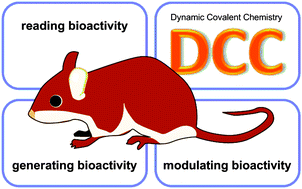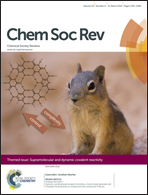Dynamic combinatorial/covalent chemistry: a tool to read, generate and modulate the bioactivity of compounds and compound mixtures†
Abstract
Reversible covalent bond formation under thermodynamic control adds reactivity to self-assembled supramolecular systems, and is therefore an ideal tool to assess complexity of chemical and biological systems. Dynamic combinatorial/covalent chemistry (DCC) has been used to read structural information by selectively assembling receptors with the optimum molecular fit around a given template from a mixture of reversibly reacting building blocks. This technique allows access to efficient sensing devices and the generation of new biomolecules, such as small molecule receptor binders for drug discovery, but also larger biomimetic polymers and macromolecules with particular three-dimensional structural architectures. Adding a kinetic factor to a thermodynamically controlled equilibrium results in dynamic resolution and in self-sorting and self-replicating systems, all of which are of major importance in biological systems. Furthermore, the temporary modification of bioactive compounds by reversible combinatorial/covalent derivatisation allows control of their release and facilitates their transport across amphiphilic self-assembled systems such as artificial membranes or cell walls. The goal of this review is to give a conceptual overview of how the impact of DCC on supramolecular assemblies at different levels can allow us to understand, predict and modulate the complexity of biological systems.

- This article is part of the themed collection: Supramolecular and dynamic covalent reactivity

 Please wait while we load your content...
Please wait while we load your content...